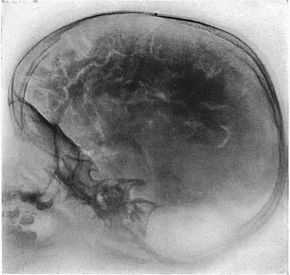| Pneumoencephalography | |
|---|---|
 Pneumoencephalography | |
| ICD-9-CM | 87.01 |
| MeSH | D011011 |
Pneumoencephalography (sometimes abbreviated PEG; also referred to as an "air study") was a common medical procedure in which most of the cerebrospinal fluid (CSF) was drained from around the brain by means of a lumbar puncture and replaced with air, oxygen, or helium to allow the structure of the brain to show up more clearly on an X-ray image. It was derived from ventriculography, an earlier and more primitive method in which the air is injected through holes drilled in the skull.
The procedure was introduced in 1919 by the American neurosurgeon Walter Dandy[1] and was performed extensively until the late 1970s, when it was replaced by more-sophisticated and less-invasive modern neuroimaging techniques.
- ^ "Walter Dandy". Society of Neurological Surgeons. Archived from the original on 2019-01-10. Retrieved 2011-04-28.